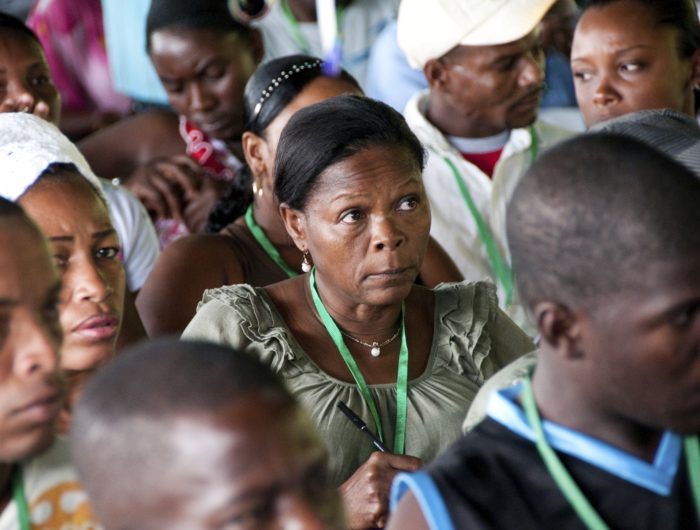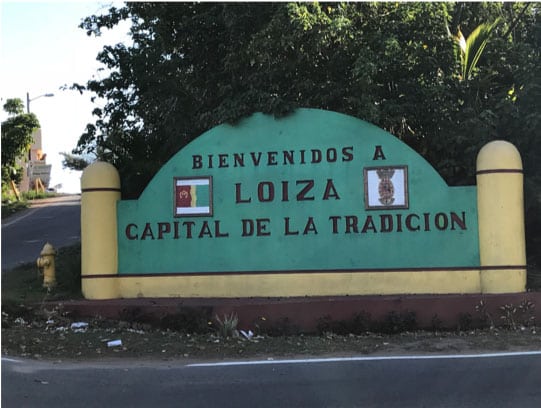In Loiza, the Afro-Boricua Population Won’t Let a Hurricane Wipe Out Their Traditions
By Eli Jacobs-Fantauzzi

Photo by Eli Jacobs Fantauzzi for Remezcla
Much like the rest of the island, Loíza – a northeastern coastal town in Puerto Rico – is still recovering from the devastating impact of Hurricane María and the (now widely reported) mismanaged and inept response by government officials. Still, despite the challenges that remain 10 months later, on July 20, in a demonstration of resilience and fortitude, grounded in culture and tradition that is uniquely Puerto Rican, the community came together to celebrate the annual Fiesta de Santiago Apóstol.
The weeklong celebration, one of the most vibrant and culturally significant on the island, attracted a crowd as diverse and colorful as the costumes and traditional garb worn by bomba dancers, young and old, who performed for smiling and enthusiastic crowds. Thousands gathered to watch caravans of men on horseback; reggaetoneros waving from their Jeeps; teenagers dancing joyfully to the latest Latin trap hit; and others, parading proudly in their traditional vejigante masks, all while children on bicycles and onlookers smiled in awe.

Photo by Eli Jacobs Fantauzzi for Remezcla
With more than half of Loíza’s 29,000 inhabitants self-identifying as Black on the most recent census, the town has the largest percentage of Afro-Boricuas on the island. It’s no wonder such a celebration would highlight and uplift the African heritage of the people. African cloth, dashikis, afros, and the colors red, gold and green (the colors of Loíza’s flag) were worn with reverence.
Bomba, a distinctly Puerto Rican style of music dating back hundreds of years, with origins as a tool of rebellion against slave owners, is still alive and thriving because of communities like Loíza. Dancers of all ages performed proudly throughout the festivities, with Afro-Boricua groups from the town – such as the celebrated traditional bomba group Majestad Negra and the popular bomba fusion group La Tribu de Abrante – taking the plaza stage to the delight of thousands of onlookers.
After experiencing so much loss, it’s evident that the people of Loíza won’t allow colonialism or a hurricane to wipe out their customs and traditions. I offer these photos as a testament to the beauty of Loíza and in gratitude for holding our culture with so much love and pride.

Photo by Eli Jacobs Fantauzzi for Remezcla

Photo by Eli Jacobs Fantauzzi for Remezcla

Photo by Eli Jacobs Fantauzzi for Remezcla

Photo by Eli Jacobs Fantauzzi for Remezcla

Photo by Eli Jacobs Fantauzzi for Remezcla

Photo by Eli Jacobs Fantauzzi for Remezcla

Photo by Eli Jacobs Fantauzzi for Remezcla

Photo by Eli Jacobs Fantauzzi for Remezcla

Photo by Eli Jacobs Fantauzzi for Remezcla

Photo by Eli Jacobs Fantauzzi for Remezcla

Photo by Eli Jacobs Fantauzzi for Remezcla

Photo by Eli Jacobs Fantauzzi for Remezcla

Photo by Eli Jacobs Fantauzzi for Remezcla

Photo by Eli Jacobs Fantauzzi for Remezcla

Photo by Eli Jacobs Fantauzzi for Remezcla

Photo by Eli Jacobs Fantauzzi for Remezcla

Photo by Eli Jacobs Fantauzzi for Remezcla

Photo by Eli Jacobs Fantauzzi for Remezcla
In Loiza, the Afro-Boricua Population Won’t Let a Hurricane Wipe Out Their Traditions
By Eli Jacobs-Fantauzzi

Photo by Eli Jacobs Fantauzzi for Remezcla
Much like the rest of the island, Loíza – a northeastern coastal town in Puerto Rico – is still recovering from the devastating impact of Hurricane María and the (now widely reported) mismanaged and inept response by government officials. Still, despite the challenges that remain 10 months later, on July 20, in a demonstration of resilience and fortitude, grounded in culture and tradition that is uniquely Puerto Rican, the community came together to celebrate the annual Fiesta de Santiago Apóstol.
The weeklong celebration, one of the most vibrant and culturally significant on the island, attracted a crowd as diverse and colorful as the costumes and traditional garb worn by bomba dancers, young and old, who performed for smiling and enthusiastic crowds. Thousands gathered to watch caravans of men on horseback; reggaetoneros waving from their Jeeps; teenagers dancing joyfully to the latest Latin trap hit; and others, parading proudly in their traditional vejigante masks, all while children on bicycles and onlookers smiled in awe.

Photo by Eli Jacobs Fantauzzi for Remezcla
With more than half of Loíza’s 29,000 inhabitants self-identifying as Black on the most recent census, the town has the largest percentage of Afro-Boricuas on the island. It’s no wonder such a celebration would highlight and uplift the African heritage of the people. African cloth, dashikis, afros, and the colors red, gold and green (the colors of Loíza’s flag) were worn with reverence.
Bomba, a distinctly Puerto Rican style of music dating back hundreds of years, with origins as a tool of rebellion against slave owners, is still alive and thriving because of communities like Loíza. Dancers of all ages performed proudly throughout the festivities, with Afro-Boricua groups from the town – such as the celebrated traditional bomba group Majestad Negra and the popular bomba fusion group La Tribu de Abrante – taking the plaza stage to the delight of thousands of onlookers.
After experiencing so much loss, it’s evident that the people of Loíza won’t allow colonialism or a hurricane to wipe out their customs and traditions. I offer these photos as a testament to the beauty of Loíza and in gratitude for holding our culture with so much love and pride.

Photo by Eli Jacobs Fantauzzi for Remezcla

Photo by Eli Jacobs Fantauzzi for Remezcla

Photo by Eli Jacobs Fantauzzi for Remezcla

Photo by Eli Jacobs Fantauzzi for Remezcla

Photo by Eli Jacobs Fantauzzi for Remezcla

Photo by Eli Jacobs Fantauzzi for Remezcla

Photo by Eli Jacobs Fantauzzi for Remezcla

Photo by Eli Jacobs Fantauzzi for Remezcla

Photo by Eli Jacobs Fantauzzi for Remezcla

Photo by Eli Jacobs Fantauzzi for Remezcla

Photo by Eli Jacobs Fantauzzi for Remezcla

Photo by Eli Jacobs Fantauzzi for Remezcla

Photo by Eli Jacobs Fantauzzi for Remezcla

Photo by Eli Jacobs Fantauzzi for Remezcla

Photo by Eli Jacobs Fantauzzi for Remezcla

Photo by Eli Jacobs Fantauzzi for Remezcla

Photo by Eli Jacobs Fantauzzi for Remezcla

Photo by Eli Jacobs Fantauzzi for Remezcla
In Loiza, the Afro-Boricua Population Won’t Let a Hurricane Wipe Out Their Traditions
Last edited:
























